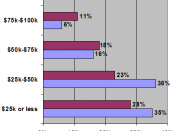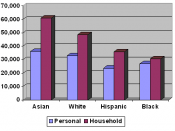NEIGHBORHOOD INEQUALITY IN CINCINNATI
The issue of racial segregation has vexed the United States for decades. Despite bitter and tumultuous struggles over the issue, the United States finds its communities still heavily segregated at the beginning of the new century. By exploring data from the city of Cincinnati, I will show that neighborhoods are segregated and the effects that segregation has on education, income, and unemployment. The minorities that I will focus on are the Black, Hispanic, and Asian communities.
When analyzing data from the suburbs of Cincinnati, at first glance statistics appear to be fairly even across the board for all races and in some cases, minorities even have an advantage over the white population. For the most part, when dealing with household income, education, and professionalism, the Whites and Hispanics are just about equal while Blacks are slightly lower by around 10% and Asians are slightly higher by about 22%.
The exception, however, is that suburban Asians are 1.5 times more likely to be college educated than Whites and as a result, have 10% less of a problem with unemployment. On the other hand, Blacks, who are only 10% less likely to go to college as Whites have an unemployment rate nearly 1.5 times the White population. The division of income into classification of poor, middle income, and affluent also produces some interesting results. The income division Whites, Hispanics, and Asians form a reverse pyramid with majority being affluent and minority being poor. In contrast to this, with the Black population, the majority is at the poor end of the pyramid where as the minority is affluent. The percent of foreign-born immigrants is highest among the Asians and has increased most among the Asians within the past 10 years. With nearly 5% of Asians...


